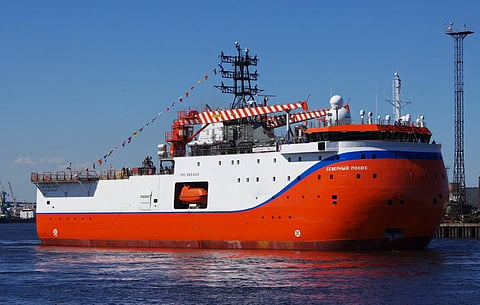

The Admiralty Shipyards division of Russia's United Shipbuilding Corporation (USC) has handed over a new research vessel to the country's Federal Hydrometeorology and Environmental Monitoring Service (Rosgidromet).
Designed by local marine engineering firm Vympel, the steel-hulled Severnyy Polyus ("North Pole") will be used to carry out year-round comprehensive scientific research in the northern portions of the Arctic Ocean. The vessel will serve as a polar research station that can stay adrift in the Arctic for up to two years without entering port. Missions will include geological, acoustic, geophysical, and oceanographic research in support of Russian economic development objectives for the Arctic and the Northern Sea Route that connects the Atlantic and Pacific Oceans.
The new ship has a length of 83.1 metres, a beam of 22.5 metres, a displacement of 10,390 tonnes, and accommodation for 14 crew members and 34 scientists and technicians. All embarked personnel are housed in single cabins, four of which also have small offices. The onboard environment also provides comfortable and safe working and living conditions for the embarked personnel even as outside temperatures drop to minus 50 degrees Celsius and humidity reaches 85 per cent.
The vessel has a prominent egg-shaped bow to minimise the impact of ice on the hull, thus ensuring sustained navigation and operations even in harsh frozen waters and reducing reliance on dedicated icebreakers. A speed of 10 knots can be achieved thanks to a main diesel engine with a rated output of 4,200 kW driving a 3,500kW rudder propeller. The onboard systems draw power from a trio of 800kW diesel generators while a 300kW generator is reserved for emergency use.
For added manoeuvrability, the vessel relies on a 1,200kW bow thruster.
The flight deck is capable of accommodating a 13-tonne utility helicopter for resupply and research support missions. Deck space is also available for an assortment of vehicles including snowmobiles, amphibious vehicles, and tractors.
Severnny Polyus is classed by the Russian Maritime Register of Shipping and was built to have an operational service life of 25 years. It currently has an Arc5 ice-class hull, though it can be reinforced to Arc8 class to improve its ability to conduct year-round operations in the Arctic. The strengthened hull can break through ice of up to 0.8 metres thick during the winter to spring period and 1.2 metres during the summer to autumn period.
The vessel will soon begin operating as part of the expeditionary fleet of the country's Arctic and Antarctic Research Institute. Its initial deployment to the Arctic is scheduled for September of this year.
| Severnny Polyus | |
| SPECIFICATIONS | |
| Type of vessel: | Research vessel |
| Classification: | Russian Maritime Register of Shipping |
| Flag: | Russia |
| Owner: | Russian Federal Hydrometeorology and Environmental Monitoring Service |
| Designer: | Vympel Design Bureau, Russia |
| Builder: | Admiralty Shipyards, Russia |
| Hull construction material: | Steel |
| Length overall: | 83.1 metres |
| Beam: | 22.5 metres |
| Displacement: | 10,390 tonnes |
| Main engine: | 4,200 kW |
| Propulsion: | Rudder propeller, 3,500 kW |
| Generators: | 3 x 800 kW; 300 kW |
| Side thruster: | 1,200 kW |
| Maximum speed: | 10 knots |
| Type of fuel: | Diesel |
| Accommodation: | Single cabins |
| Crew: | 48 |
| Operational area: | Russian Arctic Ocean |
